Introduction
Spain, with its mosaic of cultures and histories, has always been a land of vibrant celebrations. From the northern coasts of Galicia to the southern plains of Andalusia, every region boasts its own unique festivities, many of which have been celebrated for centuries. These ancient traditions, passed down through generations, offer a window into Spain’s rich past, allowing us to travel back in time and experience the spirit of bygone eras.
Spain’s rich history reflected in its festivities
The Iberian Peninsula, where modern-day Spain is located, has been a melting pot of civilizations. The Phoenicians, Romans, Visigoths, Moors, and Christians have all left their mark on the land, and with them, they brought their own set of traditions and celebrations. Over time, these festivities evolved, merged, and transformed, resulting in a rich tapestry of celebrations that are uniquely Spanish. Whether it’s the haunting laments of a flamenco song, the intricate steps of a traditional dance, or the vibrant colors of a local fiesta, each festivity tells a story of Spain’s multifaceted history.
For instance, the Fallas of Valencia, with their grandiose statues and spectacular fires, can trace their origins back to ancient pagan rituals celebrating the spring equinox. Similarly, the Semana Santa processions, which are observed with great reverence across the country, are a testament to Spain’s deep-rooted Christian heritage.
The importance of preserving ancient traditions
In an era of globalization, where cultures often blend and traditions can easily be forgotten, Spain stands out for its commitment to preserving its ancient festivities. These celebrations are not just mere events; they are a living testament to the country’s history, values, and identity. They connect the present to the past, offering both locals and visitors a chance to experience Spain’s soul.
Organizations like the Spanish Cultural Heritage Institute (Instituto del Patrimonio Cultural de España) play a crucial role in this preservation. By documenting, promoting, and supporting these festivities, they ensure that they continue to thrive and remain relevant in the modern age. Moreover, many of these traditions have been recognized by UNESCO as Intangible Cultural Heritage, further emphasizing their global significance.
Local communities are also at the heart of these celebrations. It’s their passion, dedication, and love for their traditions that keep them alive. From crafting intricate costumes to passing down songs and dances to the younger generation, it’s a communal effort that ensures these festivities continue to enchant and inspire.
Spain’s ancient festivities are more than just events on a calendar. They are a journey through time, a celebration of a rich and diverse history, and a testament to the country’s enduring spirit. Whether you’re a history buff, a cultural enthusiast, or simply a curious traveler, Spain’s oldest festivities offer a unique and unforgettable experience. So, the next time you find yourself in this beautiful country, make sure to immerse yourself in its timeless traditions and be a part of its living history.
The Bonfires of San Juan
The summer solstice, a time when days are longest and nights are shortest, has been celebrated by various cultures throughout history. In Spain, this celestial event is marked by the Bonfires of San Juan (Hogueras de San Juan), a tradition that illuminates the night with fire and festivity. This age-old celebration, deeply rooted in Spain’s cultural fabric, is a blend of pagan rituals and Christian beliefs, making it a unique spectacle to witness.
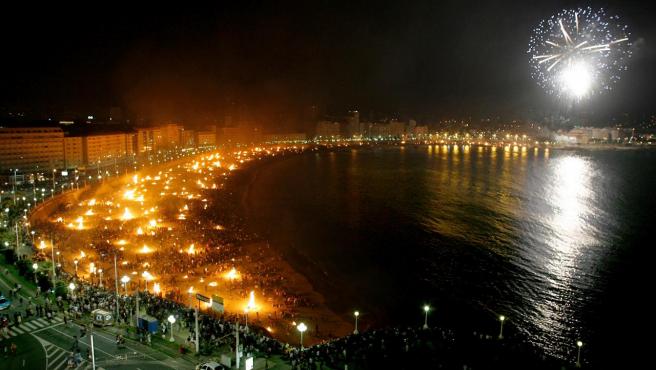
Origins and symbolism of fire
The origins of the Bonfires of San Juan can be traced back to ancient pagan rituals. Before Christianity spread across the Iberian Peninsula, local communities would light fires to honor the sun god, seeking his protection and blessings for the crops. The fire, a symbol of life and purification, was believed to ward off evil spirits and bring good fortune. People would jump over the flames, a ritual thought to cleanse the soul and bring health and vitality.
With the advent of Christianity, these pagan rituals were integrated into the celebration of the birth of Saint John the Baptist, which falls on June 24th. The fires, once lit to honor the sun god, now symbolize the light of Christ, driving away darkness and sin.
Current celebrations and their evolution
Today, the Bonfires of San Juan are celebrated with great enthusiasm, especially in regions like Galicia, Catalonia, and the Balearic Islands. As the sun sets on June 23rd, beaches and town squares come alive with bonfires, music, and dance. Families and friends gather around the fires, sharing food and stories, and waiting for midnight to partake in the ritual of jumping over the flames.
In cities like A Coruña, the celebration is particularly grand, with the entire beachfront illuminated by countless bonfires. Here, it’s also a tradition to write down wishes or things one wants to leave behind, and then throw the paper into the fire, symbolizing a fresh start.
Over the years, the Bonfires of San Juan have evolved, incorporating modern elements while staying true to their roots. In some areas, effigies representing famous personalities or events from the past year are burned, adding a contemporary twist to the ancient ritual.
While the essence of the celebration remains the same, local variations add a unique flavor to the festivities. Whether it’s the sardine funeral procession in Malaga or the water battles in Granada, each region offers its own interpretation of this age-old tradition.
The Bonfires of San Juan are not just a celebration of the summer solstice; they are a testament to Spain’s ability to preserve its ancient traditions while adapting to the changing times. For those fortunate enough to be in Spain during this time, it’s an experience not to be missed, a chance to be a part of a tradition that has been celebrated for centuries.
The Fiesta de los Mayos
As the chill of winter recedes and the vibrant hues of spring begin to paint the Spanish landscapes, a time-honored celebration emerges from the annals of history: The Fiesta de los Mayos. This festivity, deeply rooted in Spain’s cultural tapestry, is a radiant testament to the nation’s enduring connection with nature and its cyclical rhythms.
Pagan roots and the welcoming of spring
The origins of the Fiesta de los Mayos can be traced back to ancient pagan traditions that celebrated the rebirth of nature and the fertility of the land. Before the widespread adoption of Christianity, communities across the Iberian Peninsula would hold ceremonies and rituals to honor the gods of nature, seeking their blessings for a bountiful harvest. The month of May, symbolizing the peak of spring’s vitality, was the chosen time for these celebrations.
With the spread of Christianity, many of these pagan rituals were assimilated into Christian traditions. However, the essence of welcoming spring and celebrating nature’s renewal remained at the heart of the Fiesta de los Mayos.
Associated traditions and rituals
Today, the Fiesta de los Mayos is celebrated with a blend of ancient customs and modern interpretations. One of the most iconic rituals involves the crowning of the “May Queen” (Reina de Mayo), a young woman chosen to represent the spirit of spring. Adorned with flowers and garlands, she leads processions and dances that fill the streets with joy and color.
In many towns and villages, locals erect “May Poles” (Mayos), tall wooden structures decorated with ribbons, flowers, and greenery. The community gathers around these poles, dancing and singing traditional songs that echo the merriment of bygone eras.
Another cherished tradition is the “Cruces de Mayo” where beautifully adorned crosses are displayed in public squares, and neighborhoods compete to create the most stunning and elaborate designs.
In regions like Galicia, the Fiesta de los Mayos takes on a unique flavor with the “Os Maios” celebration. Here, groups create elaborate sculptures from natural materials, representing scenes from daily life or popular legends. These artworks are paraded through the streets, accompanied by songs that satirize current events and local personalities.
The Fiesta de los Mayos is not just a celebration of spring; it’s a journey into Spain’s rich past, a dance between the old and the new. It’s a reminder of the nation’s deep respect for nature and its commitment to preserving traditions that have been passed down through generations.
La Tomatina of Buñol
In the quaint town of Buñol in Valencia, the last Wednesday of August is painted red, not with paint, but with tomatoes. La Tomatina, often dubbed the world’s most vibrant food fight, is a spectacle where thousands gather to hurl tomatoes at each other, painting the town’s streets and themselves in a pulpy, juicy mess. But how did this unique and internationally renowned event come to be?
The history behind the world’s largest tomato battle
The origins of La Tomatina are somewhat shrouded in mystery, with various tales and legends associated with its inception. The most widely accepted story dates back to 1945 when, during a local parade, a group of young people accidentally caused a participant to fall off his float. In the ensuing scuffle, a nearby vegetable stand was raided, and tomatoes became the weapon of choice. The following year, these young individuals returned and started a tomato fight purely for fun. They had no idea they were laying the foundation for what would become one of Spain’s most iconic events.
Over the years, the event faced its share of challenges. It was banned during the Franco era due to its lack of religious significance. However, the people’s love for La Tomatina was undeterred. They protested the ban in 1957 by holding a mock tomato funeral, complete with a coffin and procession. The ban was eventually lifted, and the festival has since been celebrated with increasing fervor.
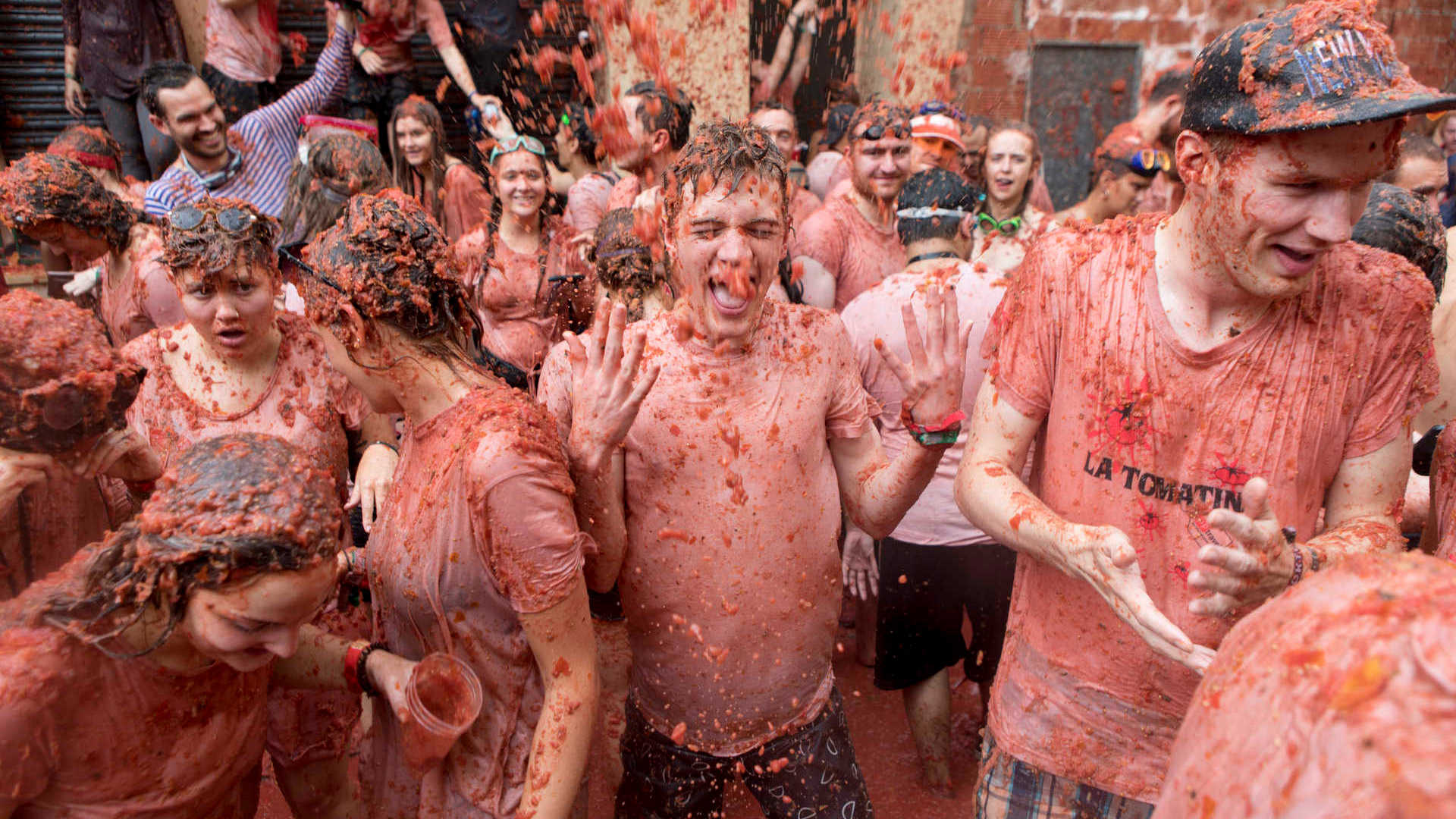
How it has gained international recognition
La Tomatina’s rise to global fame can be attributed to its sheer uniqueness and the exhilarating experience it offers. Over the years, media coverage, especially by travel channels and bloggers, has played a significant role in popularizing the event. Today, it attracts participants from all corners of the globe, with many international tourists planning their Spanish vacations around this singular event.
The local government of Buñol, recognizing the festival’s potential, has made efforts to facilitate and regulate the event for the safety and enjoyment of all participants. Tickets are now required to join the tomato-throwing, ensuring crowd control and a more organized celebration.
The cultural impact of La Tomatina has transcended borders. Variations of the festival have sprung up in other countries, and it has been featured in movies, TV shows, and advertisements, further cementing its place in global pop culture.
In essence, La Tomatina is more than just a tomato fight. It’s a testament to the Spanish spirit of joy, camaraderie, and the ability to find fun in the most unexpected places.
The Carnival of Santa Cruz de Tenerife
In the heart of the Atlantic, on the Canary Island of Tenerife, the streets come alive with a riot of colors, music, and dance every February. The Carnival of Santa Cruz de Tenerife is not just a celebration; it’s an embodiment of the island’s rich history, diverse influences, and the indomitable spirit of its people.
Historical influences and their evolution over the years
The roots of this carnival can be traced back to the earliest European settlers on the island. However, its true essence is a melting pot of cultures. From the indigenous Guanche rituals to the Spanish traditions, African rhythms, and Latin American influences, the carnival is a testament to Tenerife’s position as a crossroads of civilizations.
During the Franco regime, the carnival was the one event where people could express themselves freely, albeit under the guise of masks and costumes. This period saw the incorporation of more satirical elements, with participants using the event to covertly criticize the political situation.
Over the years, the carnival has evolved, but its core remains unchanged. It’s a celebration of life, freedom, and cultural fusion. Today, it stands as the second-largest carnival in the world, only rivaled by the iconic Rio de Janeiro Carnival.
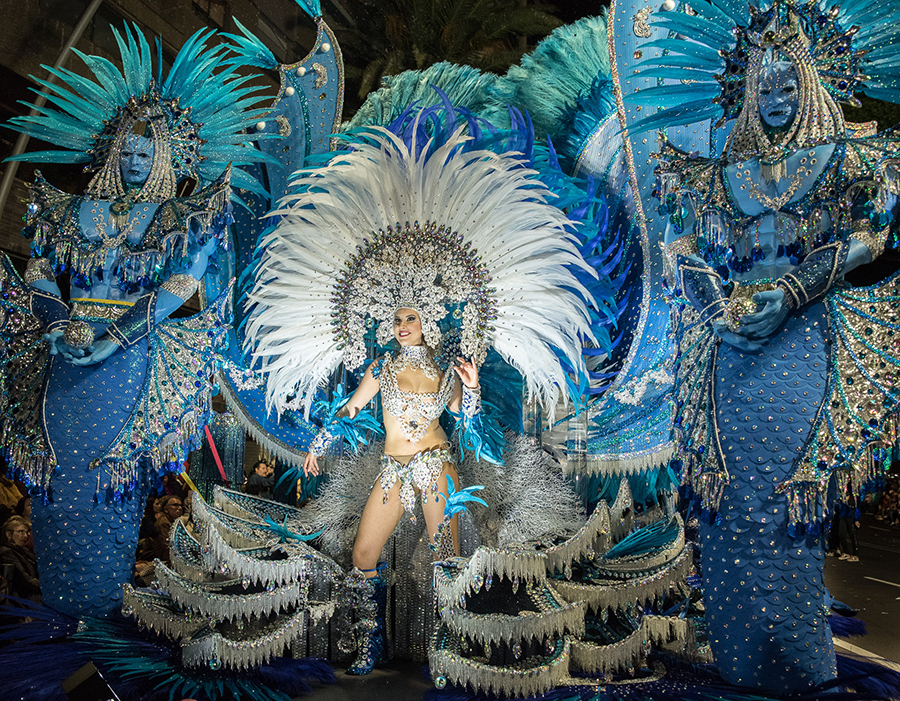
The splendor and colorfulness of current celebrations
As February dawns, Santa Cruz transforms. The streets are adorned with vibrant decorations, stages are set up for performances, and the air is thick with anticipation. The main parade, or ‘Cosmo’, is a spectacle to behold. Thousands of participants, dressed in elaborate costumes, dance to the beats of drums, Latin music, and traditional Canary songs. From majestic queens with their grandiose outfits to groups portraying different themes, the parade is a visual and auditory feast.
One of the most awaited events is the ‘Election of the Carnival Queen’. Young women, adorned in intricate costumes that often weigh several kilos and span several meters, compete for the coveted title. This event is broadcasted nationally and is a matter of pride for the locals.
But the carnival is not just about grand events. On the streets, ‘murgas’ (satirical musical groups) and ‘comparsas’ (dance groups) entertain the masses. The ‘Burial of the Sardine’, a symbolic event marking the end of the carnival and the beginning of Lent, sees a giant sardine effigy paraded and then burned, amidst much mourning and theatrics.
The Carnival of Santa Cruz de Tenerife is more than just a festival. It’s a reflection of the island’s soul, a celebration that transcends age, background, and nationality. It’s where tradition meets modernity, and the past dances with the present.
For more details and event schedules, visit the official Santa Cruz de Tenerife tourism website: webtenerife.co.uk.
The Fallas of Valencia
In the heart of Spain’s eastern coast, the city of Valencia awakens each March to the scent of gunpowder and the sound of fireworks. This is not just any celebration; this is Las Fallas, a unique festival where art meets fire in a spectacular display of creativity and tradition.
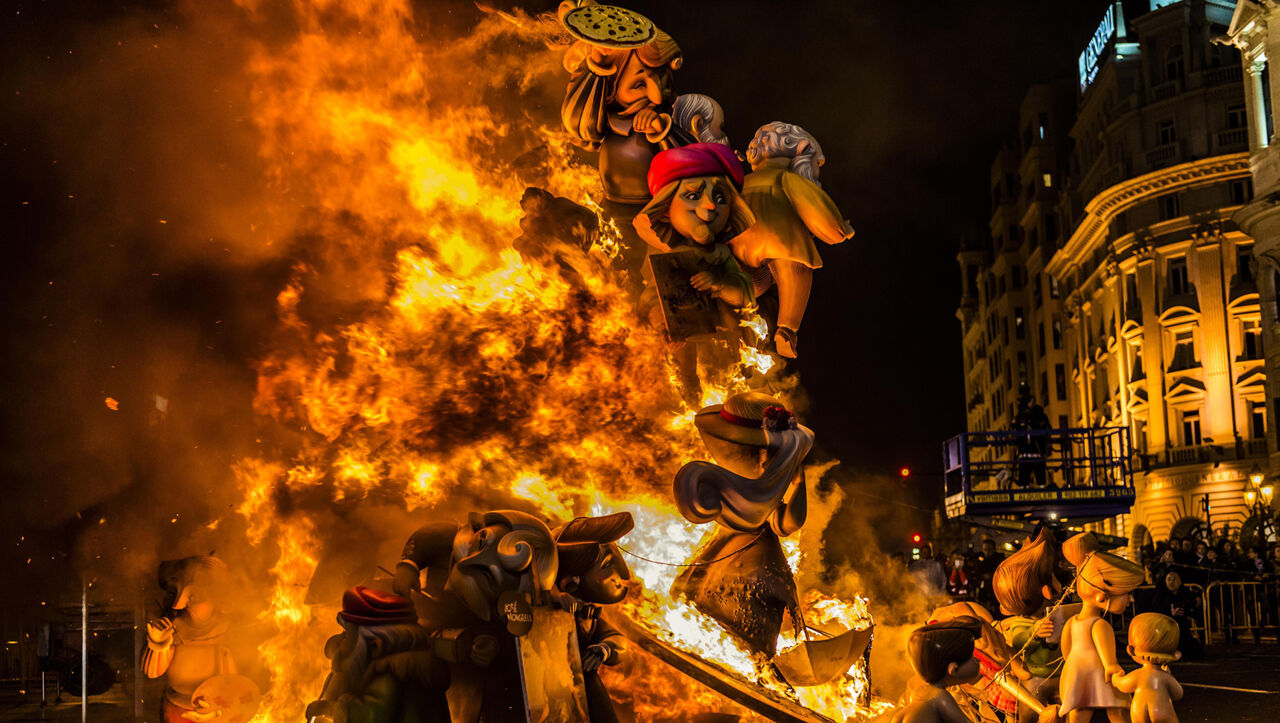
The art of building and burning monuments
Months before the actual festivities, neighborhoods across Valencia buzz with activity as artists and local communities come together to create ‘fallas’ – intricate statues made of wood and papier-mâché. These statues, often several stories high, are satirical masterpieces that depict everything from political figures and celebrities to traditional Spanish scenes and global events.
As impressive as these structures are by day, it’s at night when they truly come alive. Illuminated by thousands of lights, the fallas become the focal points of parties and gatherings, with music, dance, and revelry continuing into the early hours.
However, the true climax of the festival is the ‘La Cremà’ – the burning of the fallas. On the final night, amidst a backdrop of fireworks and emotional songs, these magnificent structures are set ablaze. This act symbolizes the destruction of the old and the rebirth of the new, a way to cleanse the past and welcome the future.
Meaning and origin of this centennial tradition
The origins of Las Fallas are somewhat debated, but the most accepted theory is that it began in the Middle Ages. Craftsmen would burn wooden planks, called ‘parots’, used to hang candles during winter. Over time, these simple burnings evolved into a competition, with neighborhoods trying to outdo each other with more elaborate structures.
The festival’s satirical edge is believed to have been influenced by Valencia’s history as a hub of trade and culture. The city’s exposure to different ideas and its tradition of questioning authority gave rise to the sharp, often humorous critiques seen in the fallas.
Today, Las Fallas is not just a Valencian event but a global phenomenon, drawing tourists from all over the world. It’s a testament to the city’s ability to preserve its traditions while adapting to the modern world.
For those wishing to immerse themselves in this fiery spectacle, the official Valencia tourism website offers a detailed guide and schedule: visitvalencia.com.
The Festival of the Patios in Córdoba
Nestled in the heart of Andalusia, Córdoba is a city steeped in history, where Roman, Moorish, and Christian influences intertwine. But come May, the city’s ancient streets and alleyways burst into a riot of colors and fragrances, thanks to the Festival of the Patios (Fiesta de los Patios).
The beauty of Andalusian patios in bloom
Hidden behind the tall, whitewashed walls of Córdoba’s historic homes are lush courtyards, or ‘patios’, that encapsulate the essence of Andalusian life. These patios, traditionally designed to provide respite from the scorching summer heat, are transformed during the festival into verdant paradises, adorned with cascading geraniums, vibrant bougainvillea, and the intoxicating scent of jasmine and orange blossom.
Walking through these open courtyards is like stepping into a living tapestry, where every hue and aroma tells a story. The festival is not just a visual feast but also a social event. Families proudly open their homes to the public, often accompanied by traditional flamenco music, creating an atmosphere of warmth and shared celebration.
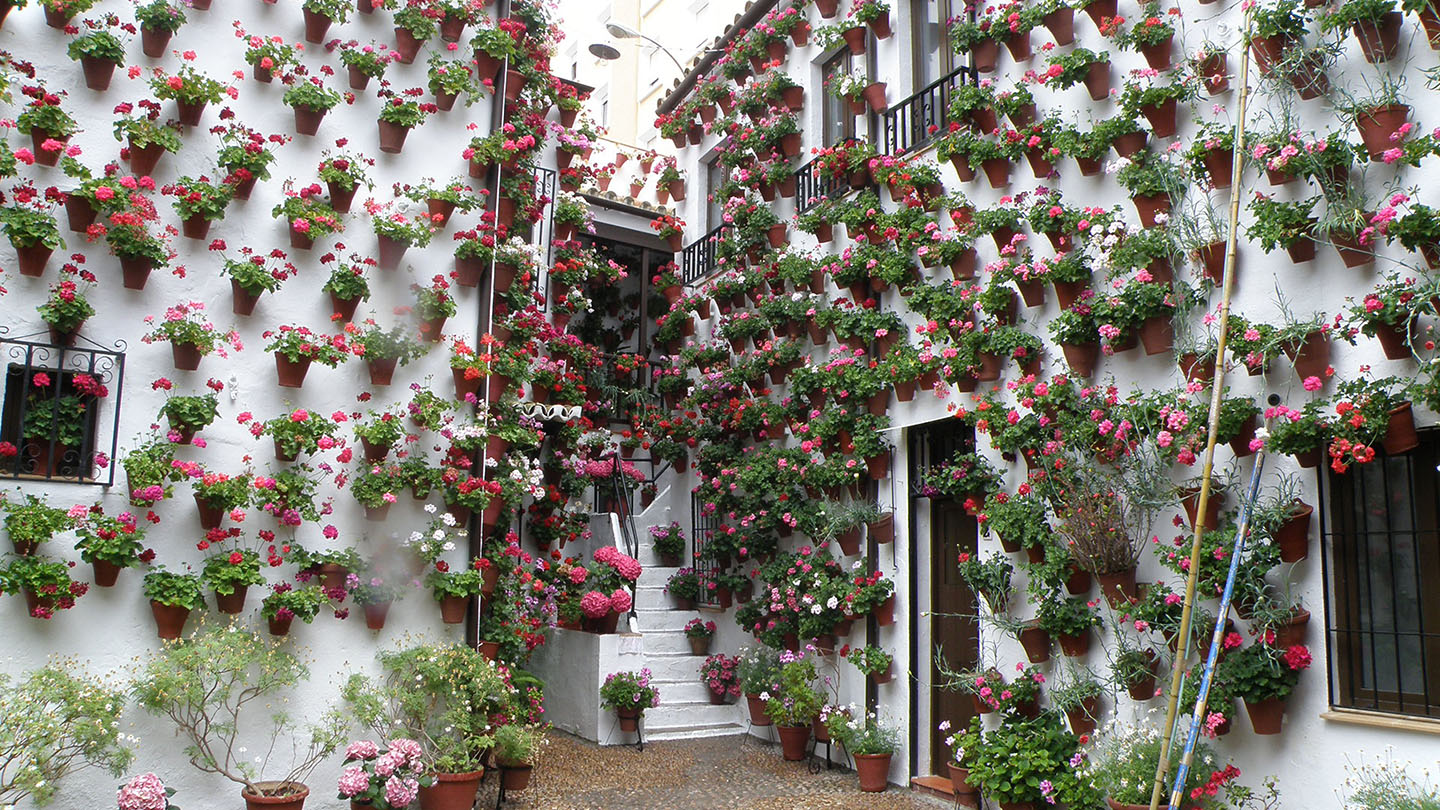
History and features of the festivity
The tradition of decorating patios dates back to Roman times, but it was during the Moorish period that it truly flourished, influenced by the Islamic culture’s love for water and gardens. The festival itself began in 1918 as a competition to find the most beautifully decorated patio in Córdoba. Today, it’s an event of international renown, drawing visitors from all corners of the globe.
Each year, a panel of judges roams the city, evaluating the patios based on their floral variety, design, and conservation of the architectural heritage. But beyond the competition, the true spirit of the festival lies in the communal joy and pride of the Cordobeses, who see it as an opportunity to showcase their rich heritage and the living history of their city.
For those planning a visit, the Córdoba Tourism Board provides a comprehensive guide, including a map of participating patios and events: visitcordoba.org.
Holy Week in Seville
In the heart of Andalusia, Seville’s streets come alive with passion, artistry, and devotion during Holy Week (Semana Santa). This deeply rooted tradition, echoing through the corridors of time, is a spectacle that captures the essence of Spain’s religious and cultural identity.
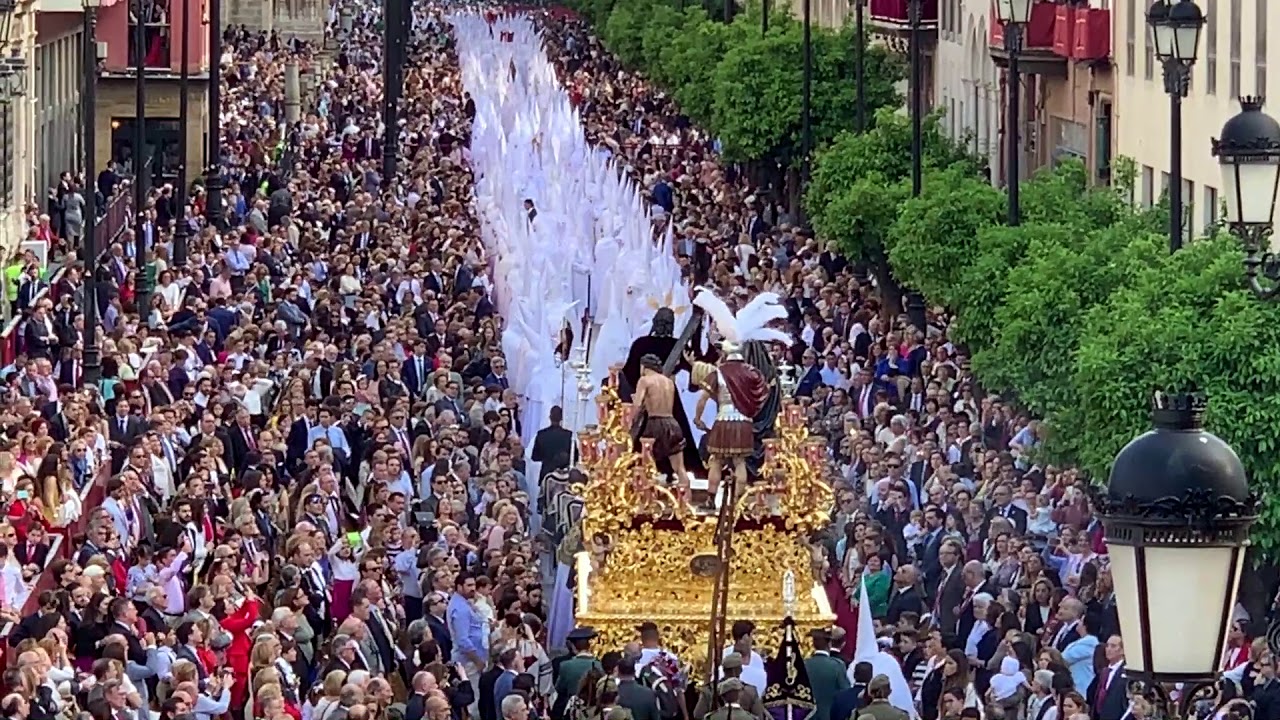
Processions, floats, and religious devotion
From Palm Sunday to Easter Sunday, Seville becomes a stage for a series of breathtaking processions. Brotherhoods (hermandades) from churches across the city carry elaborately adorned floats (pasos) depicting scenes from the Passion of Christ and the Virgin Mary. The haunting sounds of saetas, traditional Andalusian songs, pierce the air as they’re sung from balconies, expressing raw emotion and devotion.
The processions are a sensory experience: the scent of incense fills the air, the glow of candles illuminates the intricate goldwork of the floats, and the weight of history and devotion is palpable in every step of the costaleros (bearers) as they carry the heavy pasos on their necks and shoulders. The sight of the hooded nazarenos, with their tall, pointed hoods and wax candles, is both eerie and mesmerizing, evoking a sense of mystery and reverence.
Historical influence on contemporary celebration
The origins of Seville’s Holy Week can be traced back to the Middle Ages, but it was during the Counter-Reformation of the 16th century that the celebrations took on greater significance, as the Catholic Church sought to reaffirm its presence and influence in the face of Protestant reform. Over the centuries, what began as a purely religious observance has evolved, incorporating artistic, social, and cultural elements, making it a holistic representation of Sevillian and broader Spanish identity.
Today, while the religious fervor remains at its core, Holy Week in Seville is also a major cultural and tourist event. It’s a time when families come together, traditions are passed down to younger generations, and visitors from around the world flock to witness this unparalleled display of devotion and artistry.
For those interested in delving deeper into this tradition, the Seville Tourism Board offers guided tours and detailed schedules of the processions: visitseville.es.
The Dance of San Lorenzo in Huesca
Nestled in the shadow of the Pyrenees, Huesca, a quaint city in the region of Aragón, becomes a vibrant hub of tradition and festivity every August. At the heart of these celebrations is the Dance of San Lorenzo, a mesmerizing performance that has been passed down through generations, echoing the rhythms of history and devotion.
An ancestral dance in honor of the saint
The Dance of San Lorenzo, or “El Dance” as locals affectionately call it, is a tribute to Saint Lawrence, Huesca’s patron saint. Legend has it that Saint Lawrence, born in Huesca, met a martyr’s death in Rome. His unwavering faith and sacrifice are commemorated through this dance, which has been performed for centuries.
The dance is a blend of ancient Iberian, Moorish, and Christian influences, reflecting the rich tapestry of cultures that have shaped the region. Dancers, dressed in traditional white shirts, red sashes, and black trousers, move to the rhythmic beats of drums and the piercing notes of bagpipes. The choreography, a mix of jumps, turns, and coordinated footwork, is both a spiritual offering and a display of communal unity.
Distinctive elements and features
What sets the Dance of San Lorenzo apart is its unique combination of music, lyrics, and choreography. The songs, sung in the ancient Aragonese language, narrate tales of battles, love, despair, and hope. These are not just mere performances; they are stories, oral histories passed down, preserving memories of times gone by.
Another distinctive feature is the “Danzeta”, a slower, more solemn dance performed in the church’s cloister, symbolizing the deep religious reverence associated with the festivity.
While the Dance of San Lorenzo is undeniably rooted in the past, it is very much a living tradition. Every year, young members of the community join the ranks, learning the steps, songs, and, more importantly, the spirit of the dance. It’s a testament to Huesca’s commitment to preserving its heritage while ensuring its continuity for future generations.
For those intrigued by this captivating tradition, the Huesca Tourism Office provides detailed information and schedules of the festivities: visithuesca.com.
Conclusion
Spain, with its millennia of history, has always been a melting pot of cultures, traditions, and festivities. From the northern mountains of the Pyrenees to the southern shores of Andalusia, every region, every city, and every village has a story to tell, often expressed through its unique and vibrant celebrations.
Reflection on the richness and diversity of Spanish festivities
The festivities we’ve explored in this series are but a glimpse into the vast tapestry of traditions that Spain has to offer. Each festivity, whether it’s the fiery passion of the Bonfires of San Juan or the rhythmic beats of the Dance of San Lorenzo, encapsulates a piece of Spain’s soul. They are not just events on a calendar but are living, breathing entities that evolve, adapt, and grow with each passing year, while still retaining their core essence.
These celebrations are a testament to Spain’s ability to honor its past while looking forward to the future. They showcase a nation that values its roots, understands the importance of community, and takes immense pride in its cultural heritage. The diversity of these festivities, from the solemnity of Holy Week in Seville to the playful chaos of La Tomatina, mirrors the diversity of the Spanish people themselves – a harmonious blend of old and new, sacred and secular, tradition and innovation.
An invitation to immerse oneself in Spain’s living history through its festivals
For travelers and enthusiasts alike, these festivities offer more than just entertainment. They offer an opportunity to step back in time, to immerse oneself in a living history, and to experience Spain in its most authentic form. It’s a chance to join the locals in their celebrations, to understand their stories, their joys, their sorrows, and their hopes. It’s a chance to be a part of something bigger, something timeless.
So, to all who read this, consider this an open invitation. Come to Spain. Dive deep into its traditions. Dance to its rhythms, sing its songs, and let yourself be swept away by its charm. Because in Spain, history is not just something you read about; it’s something you live.
For more information on these and other festivities, the Spanish Tourist Office provides comprehensive guides and schedules: spain.info.





